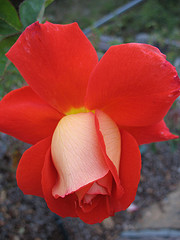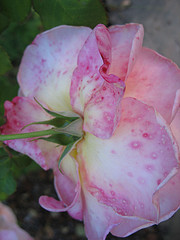As a fitting follow-up to my tour of the Berkeley Rose Garden, here are some thoughts about plants and other “inanimate” objects from the Indian Scientist Jagadis Chandra Bose in the early 1900’s, as recounted by Paramahansa Yogananda, in his Autobiography of a Yogi:
“The telltale charts of my crescograph are evidence for the most skeptical that plants have a sensitive nervous system and a varied emotional life. Love, hate, joy, fear, pleasure, pain, excitability, stupor, and countless appropriate responses to stimuli are as universal in plants as in animals…A universal reaction seemed to bring metal, plant and animal under a common law. They all exhibited essentially the same phenomena of fatigue and depression, with possibilities of recovery and of exaltation, as well as the permanent irresponsiveness associated with death…”
“By first chloroforming a huge tree, I achieved a successful transplantation. Usually, such monarchs of the forest die very quickly after being moved.” Jagadis smiled happily as he recounted the life-saving maneuver. “Graphs of my delicate apparatus have proved that trees possess a circulatory system; their sap movements correspond to the blood pressure of animal bodies. The ascent of sap is not explicable on the mechanical grounds ordinarily advanced, such as capillary attraction. The phenomenon has been solved through the crescograph as the activity of living cells. Peristaltic waves issue from a cylindrical tube which extends down a tree and serves as an actual heart! The more deeply we perceive, the more striking becomes the evidence that a uniform plan links every form in manifold nature.”
The effect of the chloroform discontinued all growth; the antidote was revivifying. The evolutionary gestures on the screen held me more raptly than a “movie” plot. My companion (here in the role of villain) thrust a sharp instrument through a part of the fern; pain was indicated by spasmodic flutters. When he passed a razor partially through the stem, the shadow was violently agitated, then stilled itself with the final punctuation of death.
The great scientist pointed to another Bose instrument.
“I will show you experiments on a piece of tin. The life-force in metals responds adversely or beneficially to stimuli. Ink markings will register the various reactions.”
Deeply engrossed, I watched the graph which recorded the characteristic waves of atomic structure. When the professor applied chloroform to the tin, the vibratory writings stopped. They recommenced as the metal slowly regained its normal state. My companion dispensed a poisonous chemical. Simultaneous with the quivering end of the tin, the needle dramatically wrote on the chart a death-notice.
“Bose instruments have demonstrated that metals, such as the steel used in scissors and machinery, are subject to fatigue, and regain efficiency by periodic rest. The life-pulse in metals is seriously harmed or even extinguished through the application of electric currents or heavy pressure.”


